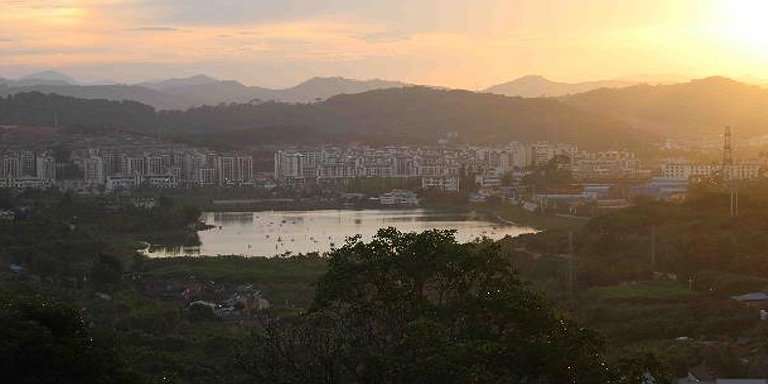East Asia Blog Series
Restoring a River the Natural Way
Brian Capati 8 Feb 2021
In the People’s Republic of China, rehabilitation of the Simao River took an ecological and green development path and was integrated into city plans.
Overview
The Simao River in Pu’er City, the People’s Republic of China (PRC) was rehabilitated to prevent flooding in the city, restore the area’s biodiversity, and improve livability for residents.
In 2012, the city government worked with the Cities Development Initiative for Asia (CDIA) to finalize the design of its rehabilitation project, which aimed to develop Simao River into an attractive landmark and improve its flood protection capacity. Soon after, KfW (German Development Bank) approved an $80-million loan to implement the key components of the project.
In 2018, CDIA development experts returned to Pu’er and saw that the measures implemented by the city, which largely adopted a nature-based approach, resulted in better flood control and more sustainable river management, improved water quality, and restored ecology of the river. Residents were also using green spaces near the river for recreation and social interaction.
Project information
PRC: Flood Control, Environmental Improvement and Water Reclamation Works in Pu’er
Project snapshot
- Start date: January 2012
- End date: June 2012
- Total project cost: $410,000
- Financing:
- KfW: $80-million loan for key components of project
- CDIA: $410,000 in technical assistance
- Municipal Government of Pu’er
- Commissioning agency: Municipal Government of Pu’er
Context
Pu’er City is situated in the southwest of Yunnan Province. It covers a floodplain of about 45,000 square kilometers, framed by green hills and mountains where the famous Pu’er tea is grown. The city’s estimated population is 200,000.
Pu’er developed into a modern urban center in recent years, but increased urbanization brought pressing challenges. It experienced frequent floods that severely affected urban activities and the future development of the city. The foul odor of garbage and sludge from the Simao River further attested to environmental deterioration.
Challenges
The Simao River traverses the urban area of Pu’er. The 15-km long watercourse acts as a natural drainage channel for the city and serves as a home for wildlife and vegetation along its shores. In previous years, however, the river lost its capacity to provide these environmental benefits.
In 2012, the river had a very low flood risk management capacity that it could only cope with a 5-year flood event or less. Due to the characteristics of the river’s course and riverbeds, it could not effectively drain flood waters, thus putting the city at risk of flooding.
The Simao River was also polluted. Solid waste, sludge, and aquatic plants impeded its normal water flow, and informal settlers occupied some of its riverbanks. Pu’er’s inadequate wastewater management system compounded the problem, as only 22% of the urban wastewater was collected and treated. The rest was discharged directly into the Simao River and its tributaries.
With the river’s poor water quality and surrounding environment, biodiversity could hardly thrive. This was a stark contrast to the rich flora that Yunnan Province is known for.
Pu’er’s residents perceived the Simao River as a heavy burden; they did not see it as an integrated part of their city and did not regard it as an emblematic feature of Pu’er’s natural beauty.
Solutions
The Pu’er Municipal Government prepared a feasibility study of the Simao River rehabilitation project to develop the watercourse into an attractive landmark and to prepare the city to cope with severe flood events.
Comprehensive project preparation
The city government asked CDIA to review the feasibility study and finalize the preliminary design for the Flood Control, Environmental Improvement, and Water Reclamation Works in Pu’er project.
CDIA and the Pu’er government worked closely for 6 months in 2012 to prepare the project, involving all relevant stakeholders at each critical step of the planning process. They collected information and conducted surveys, analyses, and calculations to provide a strong foundation for the design of the Simao River rehabilitation project.
By the end of CDIA’s intervention, the city was set to pursue the following measures:
- Improve the water quality through a series of treatment wetlands at the confluences of Simao River tributaries and storm water channels;
- Provide a river layout that can withstand 50-year flood events;
- Allow the river water to flow through a combination of free-flowing stream and still water sections;
- Provide an open main flood channel with vegetation situated alongside riverbanks; and
- Divide project construction into three sections and three contract packages for the entire length of the river.
In December 2012, KfW signed an $80-million loan agreement with the PRC government to implement flood control and channel improvement works for the Simao River.
Use of ecological and green development approach
The city mostly used nature-based solutions recommended by CDIA to achieve a more sustainable river rehabilitation and create a healthy and livable environment for residents. It espoused the use of ecologically sound and diverse measures, natural processes and materials, and it based restoration efforts on the idea of the features being part of the natural environment and not exclusively built structures. It also planned to entirely use native plant materials for revegetation and for reinforcing flood beds and riverbanks.
The adoption of an ecological and green development approach ensures cost effectiveness in terms of construction and maintenance, and it can also recreate a natural river environment that protects against floods and provides natural habitats for biodiversity.
Integration of the project with city development plans
The city government integrated the planned interventions with their master plan and linked the river works with other relevant urban infrastructure projects, such as wastewater management, wetland park development, and urban renewal. This approach enabled the city to pursue a project design adapted to its existing and future development needs.
Results
CDIA visited the city 6 years after it completed its technical assistance and found that the city completed 85% of the project work, including flood control, sewage interception, and river ecology restoration measures recommended in the CDIA study.
Pu’er officials noted that the risk attributed to flooding has been minimized in flood-prone areas after completion of dredging and excavation works along the river. They also expect that the river will be able to withstand a 50-year flood event when the project is completed.
The river’s water quality improved after the city reformed its wastewater management program, and the foul smell coming from the river was eliminated. There was also a noticeable increase in fish population in the still water sections of the river.
The landscape surrounding the river was rehabilitated, with 50 hectares of greening and restoration efforts along its banks giving residents new spaces for recreation.
The city used natural and indigenous materials and processes during the project and that resulted in low construction and maintenance costs. Pu’er officials are optimistic that an ecological and green development approach will improve biodiversity and promote the sustainable development of the river.
Informal settlers along the river that were exposed to flooding were transferred to relocation sites with better amenities and quality of housing units.
Finally, the roads and bridges constructed and retrofitted near the river are expected to improve mobility and access to social services for residents.

Lessons
Aided by the interventions and the commitment of relevant stakeholders, Pu’er is set to achieve its primary objective of developing the Simao River watercourse into an attractive ecological landmark while eliminating flood risks and improving the water quality of the river.
The integration of the project into the Pu’er City Master Plan paved the way for the coordinated implementation of relevant urban infrastructure projects. Meanwhile, the active participation of city officials and the affected communities in project planning and implementation strengthened their ownership of the project.
The city government linked the various project components with internal and external funding sources necessary to implement the project. It further established a governance structure, headed by the city mayor, to manage and maintain the river and its tributaries after project completion.
Key officials of the Pu’er Municipal Government are optimistic that Pu’er will serve as a model for other cities in the PRC on how to approach the problem of flood management the natural way and how to integrate flood management measures in a more sustainable manner.
References
Cities Development Initiative for Asia. 2012. Final Report: Flood Control, Environmental Improvement & Water Reclamation Works in Pu’er.
R. Baoy, E. Ringhof, and C. Yiyang. 2018. Pu’er Tracer Study. Tracer Studies on City Interventions. Cities Development Initiative for Asia.
Author

Brian Capati
Urban Development Specialist, Cities Development Initiative for Asia
This blog is reproduced from Development Asia.


